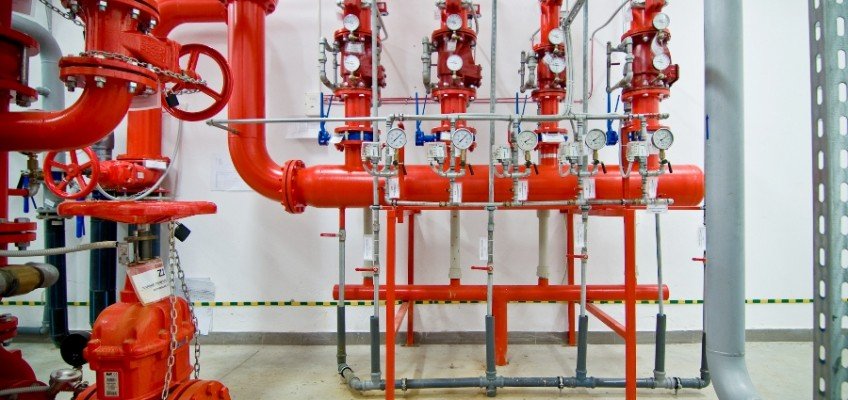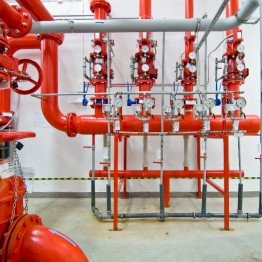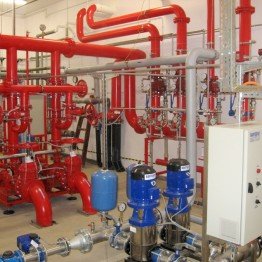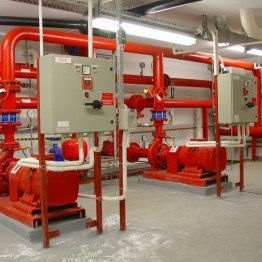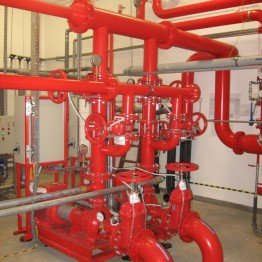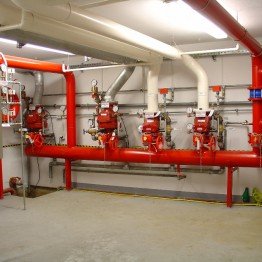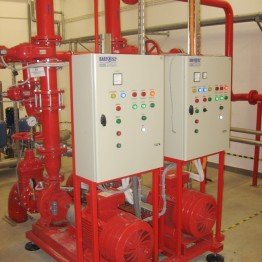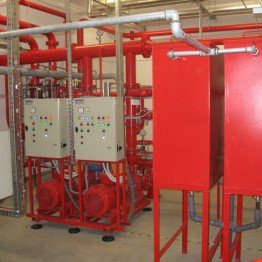Our firefighting systems with parallel-connected pumps are equipped with two to six pumps (either vertical multi-stage or horizontal or vertical single-stage pumps are used). The pumps are mounted on a foundation supported by anti-vibration feet, which gives the possibility to level the system and prevent the transfer of vibration. Each pump is fitted with non-return valves and cut-off fittings at the inlet and outlet. The pumps are connected to the suction and discharge manifolds. These manifolds are fitted with necessary sensors, pressure gauges and pressure vessels. A frame with power supply and control cabinet is attached to the supporting structure of the system (in specific cases, the cabinet can be of detachable type).
Systems supplied to our clients are wired and tested at the testing station in terms of tightness and proper operation. Each system is equipped with dry run protection, selected depending on the water supply method. Optionally, models can by equipped with a jockey pump and bypass for automatic testing of the pumps. The purpose of the jockey pump (of low delivery rate) is to keep the pressure in the fire protection system (e.g. in the case of small defects), which eliminates the need to actuate the main pumps (usually of high delivery rate) in order to stabilise the pressure. The bypass is equipped with solenoid valve (or throttle valve with electric drive), control fittings and, optionally, water meter and pressure gauge. For systems supplied from the water network, the bypass in the form of pipeline connects the suction and discharge manifolds. In the case of system supplied from the balance tank, the bypass can be provided a module mounted on the pipeline that delivers the water back to the tank. The use of bypasses allows maintaining the pumps in good operating condition, whereas the testing process is carried out automatically, within the specified time-cycle.
Basic models include the following types of units with vertical multi-stage pumps:
ZH CR – with CR pumps from Grundfos
ZH MVC – with MOVITEC pumps from KSB
ZH WR – with WR pumps from LFP Leszno
ZH SV – with SV pumps from Lowara
ZH MVI – with MVI pumps from Wilo
ZH EVM – with EVM pumps from Ebara
ZH OPA – with OPA pumps from Hydro-Vacuum
Similarly, in the case of horizontal mono-block pumps:
ZH PJM – with PJM pumps from LFP Leszno
ZH NB – with NB pumps from Grundfos
ZH SHS – with SHS pumps from Lowara
ZH 3M – with 3M pumps from Ebara
ZH EBC – with Etabloc pumps from KSB
ZH ETC – with Etachrom pumps from KSB
There are three basic types of control system:
“SPE:” the so-called multiple inverter system where every pump is equipped with its own inverter. Pressure downstream of the unit is adjusted smoothly – steplessly.
“SP”: this control system uses frequency converter to adjust the rotational speed of one pump of the pressure boosting unit. In this version, the converter is automatically switched to other pumps of the system in the right order (the so-called “rotating” converter). Pressure downstream of the unit is adjusted smoothly – steplessly.
“K”: a cascade (threshold/time varying) control system where pumps maintain pressure within set pressure thresholds (P min – P max).


